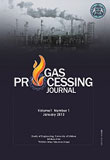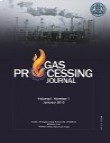فهرست مطالب

Gas Processing Journal
Volume:4 Issue: 2, Summer 2016
- تاریخ انتشار: 1395/10/30
- تعداد عناوین: 6
-
-
Pages 1-18Spherical MgO nanoparticles and Flake-like clay minerals modified with polyaniline (PAni) are applied in Matrimid in order to fabricate mixed matrix membranes (MMMs) having improved gas separation performance. The CO2 permeability, CO2/CH4 selectivity and CO2-induced plasticization pressure of MMMs are assessed at 4-30 bar feed pressure. The chemical structure, morphology and thermal properties of MMMs are analyzed by Fourier transform infrared equipped with attenuated total reflection (FTIR-ATR), X-ray diffraction, field emission scanning electron microscopy (FESEM) and differential scanning calorimetry/thermogravimetric analyses. Crater-like morphology is seen for MMMs by FESEM tests Physical interaction of Matrimid with MgO and PAni, confirmed by FTIR-ATR, helps better distribution of both the fillers in the polymer matrix. Mechanistical analysis of gas sorption and diffusion terms reveals that PAni/clay (PC) enhances gas permeability by controlling diffusivity paths, while MgO nanoparticles improves both gas solubility and diffusivity. The permeability tests reveal that the sample PC5M5 with 5 wt% PC and 5 wt% MgO, has the best gas separation properties. High pressure tests reveal that this sample can enhance plasticization pressure and CO2 permeability as well by 76% and 200%, respectively; resulting in 425% enhancement in MMMs capacity in natural gas sweetening.Keywords: CO2 removal, mixed matrix membrane, Matrimid, plasticization
-
Techno-Economic Assessment of Different Inlet Air Cooling Systems in Warm Dry & Wet Climate StationsPages 19-31Performance of a gas turbine mainly depends on the inlet air temperature. The power output of a gas turbine depends on the flow of mass through it. This is precisely the reason why on hot days, when air is less dense, power output falls. The objective here is to assess the advanced systems applied in reducing the gas turbine intake air temperature and examine the merits from integration of the different air-cooling methods in two 25 MW gas-turbine-based gas pipeline stations. Four different intake air-cooling systems are applied in two pipeline gas stations. The calculations made on annual basis of operation.
The techno-economic and exergoeconomic analysis of heat recovery of gas exhaust is assessed for Turbo-compressor Station through this proposed inlet air cooling system. Modifications are applied on a MAPNA 25 MW gas turbine in compressor station. The configuration of gas turbines in compressor station is based on (3) arrangement. In this context, a heat recovery steam generator and a steam turbine are added for three gas turbines as a proposed combined cycle.
The case study is run on Assaloyeh and Qom pipeline gas stations in Iran Gas Trunk line 8. Thermodynamic simulation, mechanical design and economic analysis are run in Thermoflow (GT PRO module) software. The thermodynamic, economics and exergoeconomic parameters from integration of different cooling systems in this proposed combined cycle are calculated and compared.Keywords: Integration_Gas_to_liquid_Fischer – Tropsch_Exergy -
Pages 32-44Recent developments in gas-to-liquid conversion industry lead to reduction in initial investment, and it is expected by growth in demand for refined products in countries and the need to import these products in the countries. Implementing such projects can prevent currency outflow. In this article an integrated structure is developed for producing liquid fuels from natural gas through Fischer-Tropsch synthesis. This integrated structure consists of steam and gas turbines and HRSG heat exchanger for power and heat recovery. Auto thermal reforming method, due to its high efficiency and exothermic nature is developed here for producing the synthesized gas. The exergy analysis indicates that the highest destruction rate of the equipment is related to the Fischer-Tropsch synthesis unit by 37.34% and the lowest to the gas turbine by 0.3%. The amounts of exergy destruction in compressors and pumps, gas turbine and steam turbine are 2.51%, 0.29% and 3.26%, respectively. The more the rate of exergy destruction in compressors, pumps and turbines, the more the rate of consumed power in the aforementioned equipment; consequently, the exergy destruction in theses equipment should be minimized. The overall thermal efficiency (HHV base) of this Integrated structure is 65.55%, which yields 9 MW power for industrial and residential consumption, and heat with the amount of 21 MW for utilizing in reboilers.Keywords: Integration, Gas-to-liquid, Fischer–Tropsch, Exergy
-
Pages 45-64In the first part of two section paper, a mathematical model of the fluidized bed reactor in the presence of in-situ water adsorbent for methanol synthesis is assessed. The bubbling two-phase regime is applied to model the fluidization concept. The binary adsorbent and catalyst particles system can be separated from each other based on their density difference. The heavy catalyst particles tend to sink and the light adsorbent particles tend to rise. The inducement for in situ water vapor removal by using adsorbent particles (Zeolite 4A) is to displace the water-gas shift equilibrium to improve methanol productivity. This is accomplished through the methanol synthesis process.
Simulation result indicate that selective adsorption of water in the fluidized bed configuration leads to 46.36% and 41.88% enhancement in methanol production and 26.143% and 25.63 % in selectivity, compared with the zero solid mass ratio condition and conventional reactor, respectively. This model is applied in a multi-objective optimization and decision making method to be presented in the upcoming study, Part II.Keywords: Methanol synthesis, Mathematical model, Fluidized bed reactor, Zeolite 4A, Adsorption -
Pages 65-78Characterization of heavy end, as plus fraction, is among the most crucial steps in predicting phase behavior of a hydrocarbon fluid system. Proper selection of single carbon number (SCN) distribution function is essential for heavy end characterization. The SCN distribution function is subject to fluid nature. The exponential distribution function has been and is widely applied to gas condensate plus fractions. More complicated functions are necessary in systems with jumps or discontinuities in successive SCN groups. Thirty fluid samples of a supergiant gas condensate reservoir are analyzed, most of which showing a discontinuity at SCN=10. A three-coefficient model is developed and then applied to determine the distribution function. The plus fraction is divided into three zones, each characterized by an adjustable parameter. A global optimization algorithm is developed and then applied to obtain unique coefficients for complete set of samples. This developed model predicts the experimental data with 10.6% accuracy and is in better agreement with experimental data compared to existing distribution functions.Keywords: three-coefficient model, fluid characterization, gas condensate, distribution function
-
Pages 79-88The primary objective of this paper is to enhance the water-vapor-adsorption capacity of multiwall-carbon-nanotube (MWCNT) from nitrogen gas by grafting sulfonic acid groups and doping palladium nanoparticles into the adsorbent. MWCNT has been selected to be modified because of having homogeneous adsorption energy compared to silica gel. As a result, it is capable of creating isotherm having sharp rising zone which is an important feature for gas dehydration application. For this purpose, MWCNT functionalized by hydroxyl groups (MWCNT-OH) was utilized to produce MWCNT functionalized by sulfonic acid groups (MWCNT-OSO3H), MWCNT-OH doped by palladium nanoparticles (MWCNT-OH-Pd) and MWCNT-OSO3H doped by palladium nanoparticles (MWCNT-OSO3H-Pd). Thermal and mass stability, Fourier-transformation infrared and atomic absorption analyses supported the fact that the functional groups and palladium nanoparticles were placed successfully throughout the carbon nanotubes. Then, the water-vapor adsorption isotherms of MWCNT-OH, MWCNT-OSO3H, MWCNT-OH-Pd and MWCNT-OSO3H-Pd were obtained at two temperatures of 15 and 24 oC. The water-vapor adsorption experiments revealed that by substituting sulfonic acid groups for the hydroxyl ones the adsorption of water vapor was enhanced only for higher gas humidity. However, by intercalating palladium nanoparticles into MWCNT-OSO3H the capacity for water-vapor adsorption was improved for lower gas humidity as well. The obtained isotherms followed the isotherms type of V which is prevailing in water-vapor adsorption systems.Keywords: Adsorption, gas dehydration, carbon nanotubes, functionalization


